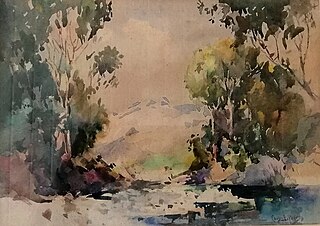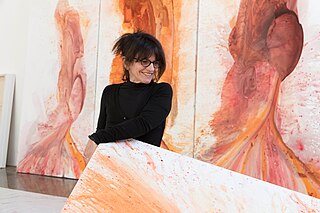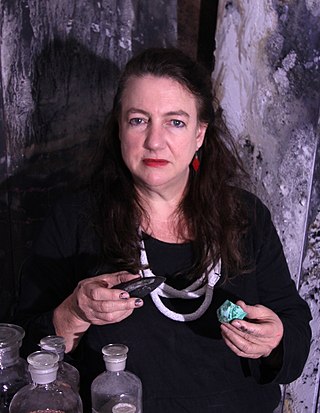Brett Murray is a South African artist mostly known for his steel and mixed media wall sculptures. He was born in Pretoria, South Africa. Murray has a master's degree in fine art from the Michaelis School of Fine Art, 1989. Referred to by critic Brenda Atkinson as "the dark prince of South African pop (art)", Murray is one of the country's most popular artists, often using easily recognisable media images with the addition of a subversive and bitterly funny twist. Murray's work addresses the wars of the cultures, the clash between Afrocentrism and Eurocentrism, the old and the new South Africas. "With my work I hope to critically entertain. Through satirical and tragic reflections on South Africa, I hope to shift people's perspectives and change people's minds, indulgent, arrogant and pretentious as this might sound," he says. More recently, his work has explored his own personal experiences and identity. Murray was also the founder of the sculpture department at Stellenbosch University.

The Iziko South African National Gallery is the national art gallery of South Africa located in Cape Town. It became part of the Iziko collection of museums – as managed by the Department of Arts and Culture – in 2001. It then became an agency of the Department of Arts and Culture. Its collection consists largely of Dutch, French and British works from the 17th to the 19th century. This includes lithographs, etchings and some early 20th-century British paintings. Contemporary art work displayed in the gallery is selected from many of South Africa's communities and the gallery houses an authoritative collection of sculpture and beadwork.
Jeremy Wafer is a South African sculptor and printmaker.
Buysile "Billy" Mandindi (1967–2005) was a black South African activist-artist who participated in a landmark protest in Cape Town in 1989, the so-called Purple Rain Protest. Later, still covered with the purple dye that riot police sprayed on protesters, Mandindi created a linocut celebrating the spirit of freedom.

Judith Mason born Judith Seelander Menge was a South African artist who worked in oil, pencil, printmaking and mixed media. Her work is rich in symbolism and mythology, displaying a rare technical virtuosity.
Matthew Hindley is a South African painter. He graduated from the Michaelis School of Fine Art, Cape Town in 2002, where he was awarded the Michaelis Prize.
Nandipha Mntambo is a South African artist who has become famous for her sculptures, videos and photographs that focus on human female body and identity by using natural, organic materials.
James Webb is a South African artist best known for his interventions and installations incorporating sound. Webb also works as a sound designer, curator and teacher. His sound installations place special emphasis on the sourcing and presentation of the sound clips, as well as the social significance and context of these sounds. Often referred to as a "collector of sounds," Webb is interested in the role that aural events play in our everyday life. The physical presentation of the work, including the installation space and the logistics of speakers, are also deliberate choices for Webb.

Israel-Isaac Lipshitz, known as Lippy Lipshitz was a South African sculptor, painter and printmaker. He is considered to be one of the most important South African sculptors, along with Moses Kottler and Anton van Wouw.
Mary Sibande is a South African artist based in Johannesburg. Her art consists of sculptures, paintings, photography, and design. Sibande uses these mediums and techniques to help depict the human form and explore the construction of identity in a postcolonial South African context. In addition, Sibande focuses on using her work to show her personal experiences through Apartheid. Her art also attempts to critique stereotypical depictions of women, particularly black women.

Charles Ernest Peers was a South African artist.

Penny Siopis is a South African artist from Cape Town. She was born in Vryburg in the North West province from Greek parents who had moved after inheriting a bakery from Siopis maternal grandfather. Siopis studied Fine Arts at Rhodes University in Makhanda, completing her master's degree in 1976, after which she pursued postgraduate studies at Portsmouth Polytechnic in the United Kingdom. She taught Fine Arts at the Technikon Natal in Durban from 1980 to 1983. In 1984 she took up a lectureship at the University of the Witwatersrand in Johannesburg. During this time she was also visiting research fellow at the University of Leeds (1992–93) and visiting Professor in Fine Arts at Umeå University in Sweden (2000) as part of an interinstitutional exchange. With an Honorary Doctorate from Rhodes University, Makhanda – Siopis is currently Honorary Professor at Michaelis School of Fine Art, University of Cape Town.
Deborah Bell is a South African painter and sculptor whose works are known internationally.
iQhiya is a network of young black women artists based in Cape Town and Johannesburg, South Africa. They specialise in a broad range of artistic disciplines including performance art, video, photography, sculpture and other mediums.

Zelda Nolte (1929–2003) was a South African- British sculptor and woodblock printmaker.

Jeannette Unite is a South African artist who has collected oxides, metal salts and residues from mines, heritage and industrial sites to develop paint, pastel and glass recipes for her large scale artworks that reflect on the mining and industrial sites where humanity's contemporary world is manufactured.

Victor Gordon is a visual artist born in South Africa. Gordon is primarily a painter and sculptor. He also creates installations assemblages, collages, drawings and photographs.
Kagiso Patrick "Pat" Mautloa is a multi-media visual artist based in Johannesburg, South Africa.
Gerald Machona is a Zimbabwean Visual contemporary artist .The most recognizable aspect of his work is his use of decommissioned Zimbabwean dollars. Machona works in sculpture, performance, new media, photography and film. In Machona's work, he explores issues of migration, transnationality, social interaction and xenophobia in South Africa.

Ângela Ferreira is a Portuguese and South African installation artist, video artist, photographer and sculptor. She spends time in both countries.









